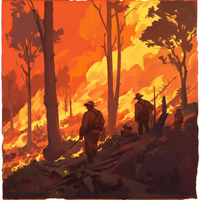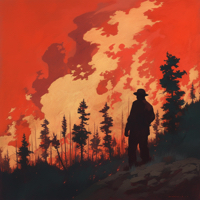 A deer hunter — not pot growers, as some politicians with an agenda publicly stated — started the Rim Fire that burned through over 237,341 acres of land in the Stanislaus National Forest and Yosemite National Park before firefighters finally got the upper hand. The 402 square mile fire blazed through more than $127 million of taxpayer money just fighting it. It began in the steep hills of the remote Jawbone Ridge area to the east of Groveland on August 17, 2013 and quickly spread out of control. Losses are estimated to be in excess of $50 million.
A deer hunter — not pot growers, as some politicians with an agenda publicly stated — started the Rim Fire that burned through over 237,341 acres of land in the Stanislaus National Forest and Yosemite National Park before firefighters finally got the upper hand. The 402 square mile fire blazed through more than $127 million of taxpayer money just fighting it. It began in the steep hills of the remote Jawbone Ridge area to the east of Groveland on August 17, 2013 and quickly spread out of control. Losses are estimated to be in excess of $50 million.
Category Archives: Wildfire
 Press release from the USDA:
Press release from the USDA:
Stanislaus Forest Supervisor Susan Skalski today announced the second phase of the Rim Fire recovery, Notice of Intent to prepare an Environmental Impact Statement (EIS) that will appear in the Federal Register December 6. The proposed action will include:
 Based on changing weather trends, increases in relative humidity and a decrease in average temperatures, the Sierra National Forest is lifting the fire restrictions that were put in effect July 2.
Based on changing weather trends, increases in relative humidity and a decrease in average temperatures, the Sierra National Forest is lifting the fire restrictions that were put in effect July 2.
Forest Visitors will still need to obtain a campfire permit when camping outside of designated campgrounds and follow all guidelines when having an open flame fire.
The following guidelines for forest campfires remain in effect:
- Clear all flammable material away from the fire for a minimum of five feet in all directions to prevent escape of the fire;
- Have a shovel available at the campfire site for preparing and extinguishing campfires;
- Have a responsible person in attendance at all times;
- Extinguish campfire with water, using the ‘drown, stir, and feel’ method; and
- In the wilderness, no campfires above 10,000 ft. (this varies by area, and will be posted on individual wilderness permits).
 Tioga Pass opens to through traffic at Noon on Saturday, September 14
Tioga Pass opens to through traffic at Noon on Saturday, September 14
From the NPS: SR-120 (Tioga Road) which had been closed from Crane Flat to White Wolf, within Yosemite National Park, will reopen to all vehicular traffic at noon, Saturday, September 14, 2013.
 The California Department of Fish and Wildlife has posted a press release directed at hunters:
The California Department of Fish and Wildlife has posted a press release directed at hunters:
With the historic Rim fire in Tuolumne and Mariposa counties still burning, the California Department of Fish and Wildlife (CDFW) is reminding hunters about limited access and road closures in the Stanislaus National Forest.
The still burning wildfire is the third largest ever recorded in California. CDFW implores that all outdoorsmen and outdoorswomen to be good stewards of the state’s wildland resources and obey all laws and restrictions regarding uses of valuable public land forests and ranges.
Deer hunters deal with wildfires and their impacts on hunting access nearly every year. Fish and Game Commission (FGC) regulations prohibit CDFW from allowing a hunter to exchange a deer tag after the earliest season (archery or rifle) has opened or if the tag quota for the zone has filled; and prohibits CDFW from issuing a refund to hunters after a season has started.
Archery deer season was underway when the fire started and so exchanges or refunds cannot be issued. CDFW staff will be reviewing our regulations to assess whether in 2014 we can recommend an approach to the FGC that would not inadvertently penalize hunters when such events occur.

